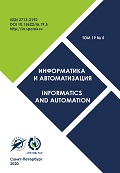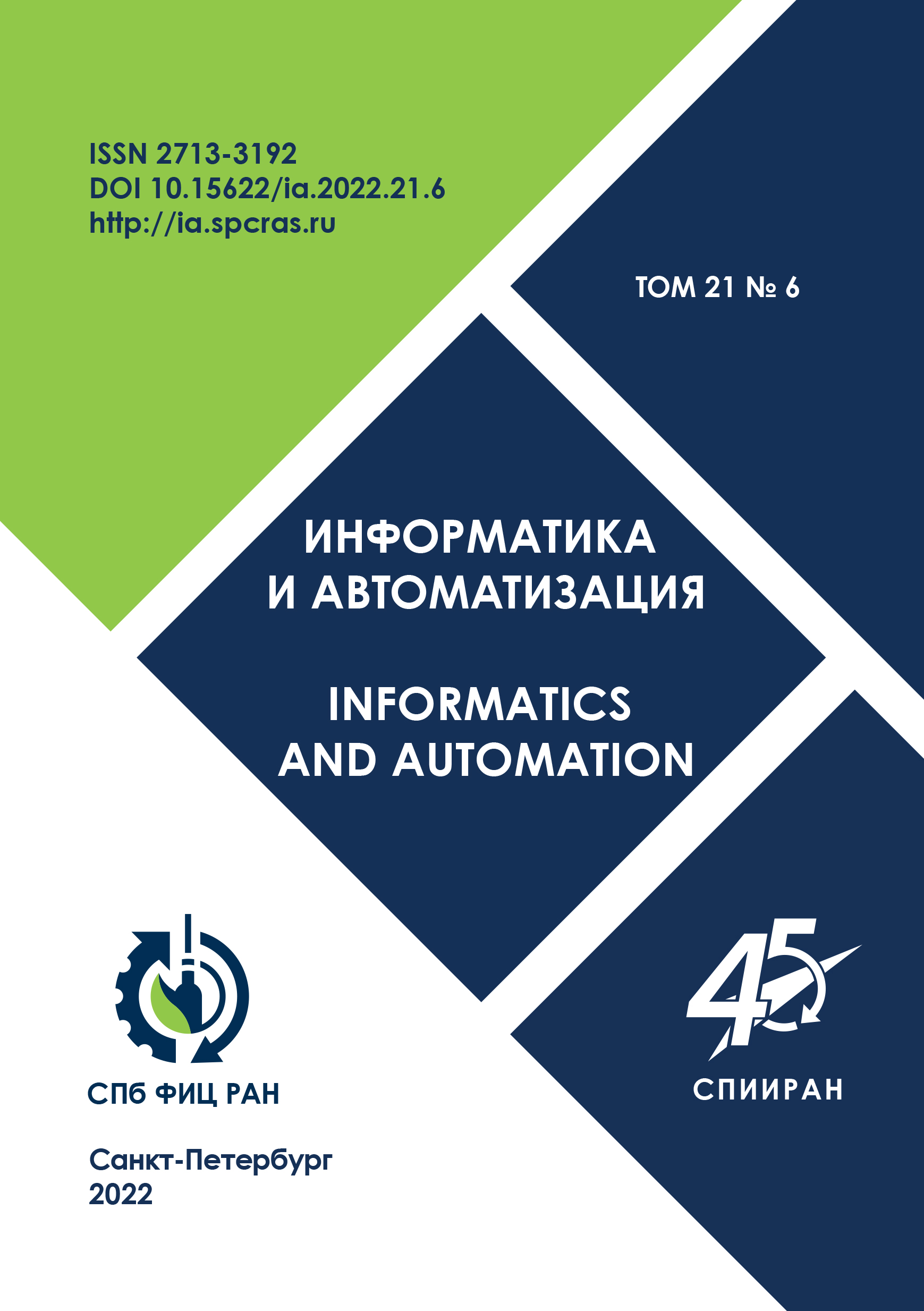Recurrent Neural Networks with Continuous Learning in Problems of News Streams Multifunctional Processing
Keywords:
recurrent neural networks, intelligent news processing, multifunctionality, continuity of learning, forecastingAbstract
The main task of using neural networks is the prompt and accurate solution of various creative tasks, including the analysis and synthesis of news flows, while maintaining the continuity of learning. The result of such processing can be digests, filtered news streams, as well as event forecasts that allow for proactivity in management decisions. Known methods of news processing by neural networks and technical solutions that implement them do not fully provide a solution to the problems that arise in this area. It is necessary to expand their functionality, and improve the space-time signal binding in recurrent neural networks. When processing news flows, simultaneously with continuous training of recurrent neural networks, selection, recognition, restoration, prediction and synthesis of news should be carried out. To reduce the severity of the problem, a promising method of multifunctional processing of news flows is proposed using recurrent neural networks with a logical organization of layers and continuous learning. The method is based on the development of associative processing of textual information in streaming recurrent neural networks with controlled elements. The key features of this method are the multifunctional processing of information flows with changing laws of news appearance. The method provides for operational selection, recognition, restoration, forecasting and synthesis of news based on deep associative continuous processing of links between text elements. The neural network system that implements the proposed method differs from the known solutions by new elements, connections between them, as well as by the functions performed. The results of the experiments confirmed the extended functionality of the method. New features of processing news texts by streaming RNNs are revealed. The proposed solutions can be used to create a new generation of intelligent systems not only for word processing, but also for other types of information.
References
2. Kaur G., Bajaj K. News Classification and Its Techniques: A Review. IOSR Journal of Computer Engineering. 2016. vol. 18. no. 1. pp. 22-26.
3. Zhang H., Boons F., Riza Batis-ta-Navarro. Whose story is it anyway? Automatic extraction of accounts from news articles. Information Processing & Management. 2019. vol. 56. no. 5. pp. 1837-1848.
4. Papagiannopoulou E., Tsoumakas G. Local word vectors guiding keyphrase extraction. Information Processing & Management. 2018. vol. 54. no. 6. pp. 888-902.
5. Osipov V., Kuleshov S., Zaytseva A., Levonevskiy D., Miloserdov D. Neural network forecasting of news feeds. Expert systems with applications. 2021. vol. 169. p. 114521.
6. Ji Z., Chen K., Wang H. Step-Wise Hierarchical Alignment Network for Image-Text Matching. Proceedings of the Thirtieth International Joint Conference on Artoficial Intelligence (IJCAAI-2021). pp. 765- 771.
7. Rivera-Trigueros I. Machine translation systems and quality assessment: a systematic review. Language Resources & Evaluation, 10 April, 2021.
8. Chaudhary and Bali. EASTER: Simplifying Text Recognition using only 1D Convolutions. The 34th Canadian Conference on Artificial Intelligence, Vancouver, 2021.
9. Grosman J., Furtado P., Rodrigues A., Schardong G., Barbosa S., Lopes H. Eras: Improving the quality control in the annotation process for natural language processing tasks. Information Systems. 2020. vol. 93. p. 101553.
10. Ashari A., Riasetiawan M. Document summarization using TextRank and semantic network. International journal intelligent systems and applications. 2017. vol. 1. pp. 26-33.
11. Mele I., Bahrainian S., Crestani F. Event mining and timeliness analysis from heterogeneous news streams. Information Processing and Management. 2019. vol. 56. pp. 969–993.
12. Curiskis S., Drake B., Osborn T., Kennedy P. An evaluation of document clustering and topic modelling in two online social networks: Twitter and Reddit. Information Processing & Management. 2019. pp. 102034.
13. Rezaeinia S., Rahmani R., Ghodsi A., Veisi H. Sentiment Analysis Based on Improved Pre-Trained Word Embeddings. Expert Systems with Applications. 2019. vol. 117. pp. 139-147.
14. Hemmatian F., Sohrabi M. A survey on classification techniques for opinion mining and sentiment analysis. Artificial Intelligence Review. 2019. vol. 52. pp. 1495–1545.
15. Li J., Chen W., Gu B., Fang J., Li Z., Zhao L. Measuring semantic relatedness with knowledge association network. Lecture Notes in Computer Science (including subseries Lecture Notes in Artificial Intelligence and Lecture Notes in Bioinformatics). 2019. vol. LNCS 11446. pp. 676-691.
16. Ardia D., Bluteau K., Boudt K. Questioning the news about economic growth: Sparse forecasting using thousands of newsbased sentiment values. International Journal of Forecasting. 2019. vol. 35(4). pp.1370 – 1386.
17. Sutskever I., Martens J., Hinton G. Generating Text with Recurrent Neural Networks. Proceedings of the 28th International Conference on Machine Learning, ICML 2011, Bellevue, Washington, USA, 2011. pp. 1017-1024.
18. Widodo A., Naomi N., Purnomo F. Prediction of Research Topics Using Combination of Machine Learning and Logistic Curve. Journal of Theoretical and Applied Information Technology. 2013. vol. 49. no. 3. pp. 725 – 732.
19. Cabana A., Mizraji E., Valle-Lisboa J. A neural model that implements probabilistic topics. Neurocomputing. 2016. vol. 171. pp. 1099-1107.
20. Wang R., Zhou D., He Y. ATM: Adversarial-neural Topic Model. Information Processing & Management. 2019. vol. 56(6). p. 102098.
21. Wei Wei, Guo C. A text semantic topic discovery method based on the conditional co-occurrence degree. Neurocomputing. 2019. vol. 368. pp. 11 – 24.
22. Mukhina K., Visheratin A., Nasonov D. Urban events prediction via convolutional neural networks and Instagram data. Procedia Computer Science. 2019. vol. 156. pp. 176-184.
23. Recurrent Neural Network Tutorial (2015), Part 4 – Implementing a GRU/LSTM RNN with Python and Theano – WildML. Available at: https://dennybritz.com/posts/wildml/recurrent-neural-networks-tutorial-part-4/. (accessed 27.10.2022).
24. Osipov V., Osipova M. Space-time signal binding in recurrent neural net-works with controlled elements. Neurocomputing. 2018. vol. 308. pp. 194–204.
25. Osipov V., Nikiforov V., Zhukova N., Miloserdov D. Urban traffic flows forecasting by recurrent neural networks with spiral structures of layers. Neural Computing and Applications. 2020. vol. 32. pp. 14885-14897.
26. Osipov V.Yu. Associativnaya intellektual'naya mashina. Informacionnye tekhnologii i vychislitel'nye sistemy. 2010. no. 2. pp. 59 – 67.
27. Osipov V., Zhukova N., Subbotin A., Glebovskiy P., Evnevich E. Intelligent escalator passenger safety management. Scientific reports. 2022. vol. 12. p. 5506.
28. Zhang J. El-Gohary N.M. Semantic NLP-based information extraction from construction regulatory documents for automated compliance checking. Journal of Computing in Civil Engineering. 2016. vol. 30. no. 2. pp. 1–14. doi: 10.1061/(ASCE)CP.1943-5487.0000346.
29. Kuleshov S., Zaytseva A., Aksenov A. Natural Language Search and Associative-Ontology Matching Algorithms Based on Graph Representation of Texts. In: Silhavy, R., Silhavy, P., Prokopova, Z. (eds) Intelligent Systems Applications in Software Engineering. Advances in Intelligent Systems and Computing. Springer, Cham, 2019. vol. 1046. pp. 285–294. doi 10.1007/978-3-030-30329-7_26.
Published
How to Cite
Section
Copyright (c) Василий Юрьевич Осипов, Сергей Викторович Кулешов, Дмитрий Игоревич Милосердов, Александра Алексеевна Зайцева, Алексей Юрьевич Аксенов

This work is licensed under a Creative Commons Attribution 4.0 International License.
Authors who publish with this journal agree to the following terms: Authors retain copyright and grant the journal right of first publication with the work simultaneously licensed under a Creative Commons Attribution License that allows others to share the work with an acknowledgement of the work's authorship and initial publication in this journal. Authors are able to enter into separate, additional contractual arrangements for the non-exclusive distribution of the journal's published version of the work (e.g., post it to an institutional repository or publish it in a book), with an acknowledgement of its initial publication in this journal. Authors are permitted and encouraged to post their work online (e.g., in institutional repositories or on their website) prior to and during the submission process, as it can lead to productive exchanges, as well as earlier and greater citation of published work (See The Effect of Open Access).






